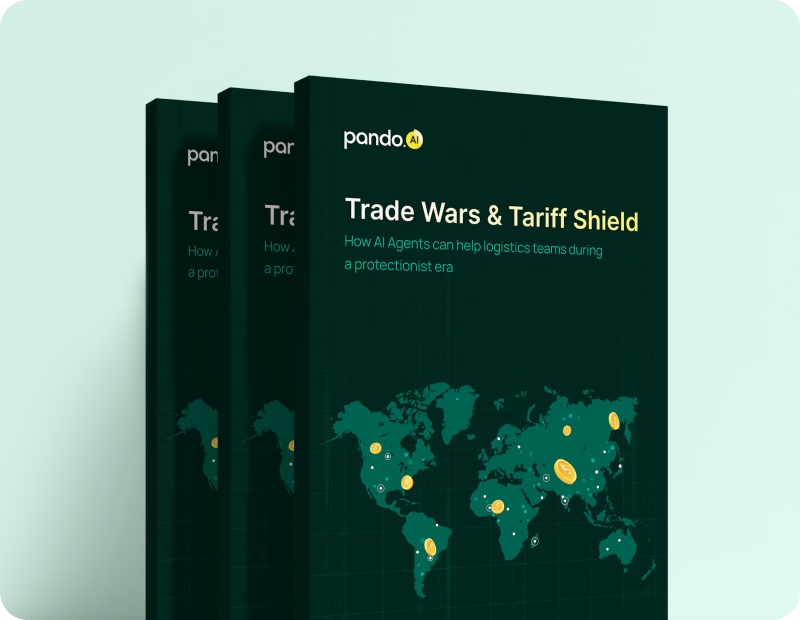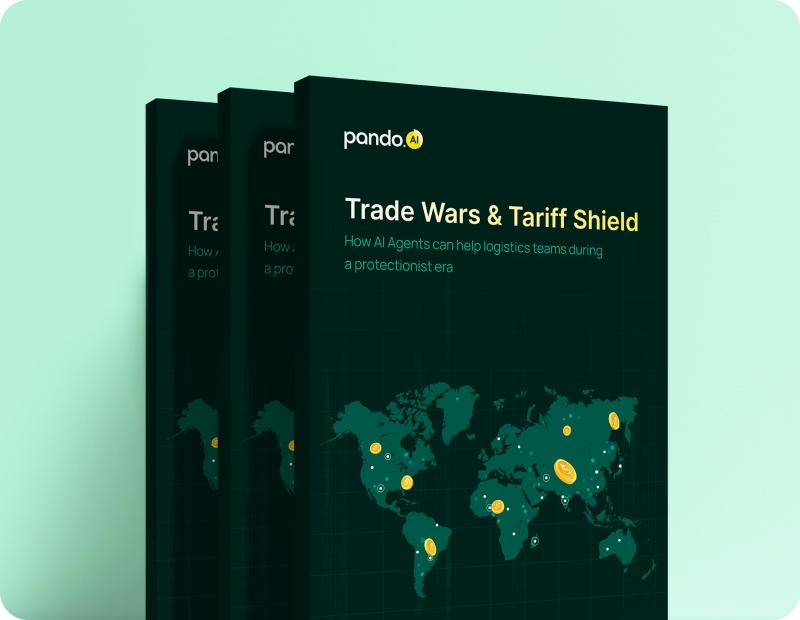-
Products Products
- Industry
- Initiatives
- Resources
- Company
- Book a demo

Before you go: Logistics leaders just dropped the truth on AI
The State of AI in Logistics 2025 is here — no hype, just real conversations and raw insights.
Freight procurement approach: A guide to modern logistics procurement
Discover effective strategies for upgrading to an advanced freight procurement tool and stay competitive in a volatile market.
Published on October 1, 2024 • 8 mins read
Rohit Lakshman

Discover effective strategies for upgrading to an advanced freight procurement tool and stay competitive in a volatile market.
Picture this: Your shipments are diverted around Africa through the Cape of Good Hope, resulting in longer transit times, unplanned voyages, and capacity shortages.
This is how the Red Sea crisis has thrown out new challenges for shippers to adjust freight management in real time and to meet demand. Relying on a generic procurement tool can lead to inefficiencies during such unexpected disruptions, making it difficult for shippers like you to manage freight procurement effectively.
Be it closed docks, road disruptions, or any other mode problems, you need visibility to adjust to current situations and allocate necessary resources to keep your logistics moving. Freight procurement upgrade is a critical strategy for overcoming the challenges of generic procurement tools, enhancing visibility, improving carrier relationships, and optimizing costs. Here is the strategy for upgrading to a specialized freight procurement tool. Before getting into the strategy section, let’s briefly examine the challenges of generic procurement tools.
The limitations of generic procurement tools
Generic procurement tools are not freight-centric, preventing scale at every touch point.
Mostly managed with manual processes like emails, calls, and Excel sheets, generic procurement tools operate in a silo and restrict visibility. As a result, you can miss business opportunities by not being able to:
-
Handle accessorial charges in the rate manager
-
Manage carrier performance scorecard
-
Automate freight bid process and RFQ
-
Help with scenario planning during market volatility
Improving freight procurement promises to deliver tailored solutions to unique shipping challenges and drive logistics efficiency and profitability. Let’s dive into the strategy for upgrading to freight procurement.
Research the core features of a freight procurement tool
The generic procurement tools can only meet direct and indirect material sourcing, thus lacking core features to support the procure-to-pay lifecycle for logistics operations. Also, not all tools are designed equally. There is a high probability of missing out on core features. You need to be judicious about the core features. To upgrade logistics procurement, consider the following core features in a freight-specific tool.
-
Rate manager and beyond:
A freight sourcing upgrade provides more than a rate management capability, which allows for complete control, visibility, and compliance with sourcing, freight audits, and payments. Ensure you can leverage standard freight rates in tandem with accessorial charges and data governance, including freight rate benchmarking, to always work with negotiated rates in any market conditions.
-
Scenario planning:
Advanced freight procurement tools must enable scenario planning so that you can make data-driven decisions for the most suitable logistics service providers and new vendors while deriving the most competitive rates in the market. Leverage advanced data analytics to work with dynamic market trends such as costs, risks, and the quality of service to analyze potential scenarios and grow in an ever-changing spot market.
-
Autonomous freight procurement
Choose a modern freight procurement system powered by AI/ML technologies to leverage autonomous freight procurement. This eliminates all mundane and manual processes, improves decision-making, and increases efficiency for use cases such as freight sourcing, contract and rate management, scenario planning, spot-buying, and post-auction analysis.
-
AI in freight procurement
With advanced data analytics, you can seamlessly access demand forecasting and optimize carrier modes based on historical data and trends. Additionally, automated procurement event management enables freight procurement optimization. Generative AI-driven AI Copilot can be another great extension to freight procurement, helping you retain or terminate contracts based on performance. As per EY, 40% of supply chain organizations are investing in GenAI, assuming it to be an agile co-advisor in optimizing logistics. Ensure that you harness AI to build resilience in your logistics operations.
-
Integration with TMS
Ensure you can gain robust visibility into freight orders in your ERP systems. This can help you retrieve sales, purchase, and stock transfer orders to automate logistics operations from manufacturing units to the end users. Integrating a procurement tool with TMS solutions can help you enhance freight procurement as demand fluctuates.
Determine the benefits of upgrading to a freight procurement tool
Force-fitting your generic procurement tool might deprive you of essential benefits. When you are careful about core features in a freight-specific procurement tool, you can drive freight procurement efficiency, cost efficiency, and risk mitigation, among others. Some essential benefits of specialized freight procurement tools include,
-
Improved freight visibility and cost control
With end-to-end transportation visibility across execution and planning, you can optimize routes during disruptions, consolidate capacity loading, and plan reverse logistics to avoid empty miles, ultimately improving cost control.
-
Enhanced carrier relationships and performance management
Freight procurement upgrades help track carrier performance effectively to make data-driven contract renewal or termination decisions. Advanced AI technology also helps remove invoice-related disputes and boost partnerships with freight forwarders.
-
Optimized freight spending and increased savings
With a specific freight procurement tool, you can gain 100% visibility into freight spend by region, modes, and carrier. By enhancing the reconciliation of accessorial charges and removing inaccurate invoices, you can avoid overpayment and boost cost efficiency.
-
Streamlined procurement processes and increased efficiency
You can automate every workflow and streamline processes from procure to pay for enhanced productivity and efficiency. Eliminating manual workloads makes your freight procurement processes strategic and effective.
-
Risk mitigation and supply chain resilience
A unified freight procurement tool provides a single source of truth for everyone throughout the fulfillment cycle to collaborate in real-time and make decisions to prevent supply chain risks and build resilience.
How to choose the right freight procurement tool
Upgrading to a specific freight procurement tool might seem to be a difficult task. A tool may provide freight-specific features, but you must also consider whether it allows for adoption, flexibility, and convenience. There are some critical factors to consider before deciding if a tool meets your specific needs. These factors are -
Industry fit:
There are tools designed to fit specific industries such as e-commerce, FMGC, manufacturing, automobiles, and so on. Choose a freight procurement tool that follows the industry's best practices with pre-populated templates to automate requests for quote or RFQ processes and help capture the correct bid.
Pando’s industry-specific pre-configured templates help logistics managers on a large scale. Here’s what they say, "The time spent on the RFQ creation has been significantly reduced by using Pando."
Intuitive UI:
Confirm you have a user-friendly and intuitive interface that allows all stakeholders or carriers to have a frictionless user experience while collaborating on various freight procurement workflows, such as RFPs, negotiations, and freight award management.
In terms of platform intuitiveness, Pando offers a competitive advantage. Click to know how clients favor Pando.
AI/ML powered:
Evaluate your specialized freight procurement tools and harness advanced AI/ML technologies to help with recommendations around carrier selection, intelligent counter bids, and scenario analysis for uninterrupted management of end-to-end procure-to-pay lifecycle from freight invoicing to payment.
Unified multimodal TMS:
A specialized freight procurement tool must combine the flexibility to facilitate multimodal TMS alongside a unified solution for the procure-to-pay lifecycle. This gives you the extended convenience of managing logistics operations for transportation execution and planning, and also enables freight audits and payments.
Integrated contract and rate management:
Leverage a tool that provides accurate rates in tandem with the price volatility based on market conditions. Embedded with a digitized rate manager, integrated contract, and continuous audit trails, you can always expect to gain accurate rates for expiring or new lanes and seamlessly track and manage accessorial charges.
With Pando, rate management for multimodal logistics is becoming a cakewalk. "Game Changing Visibility to Freight Expenses," says one of the clients at Accuride about Pando’s exceptional expense management capabilities.
Integration with the existing systems:
To optimize freight procurement, it is essential to prioritize the selected tool's integration capability. Ensure it seamlessly integrates with ERP, TMS, and generic procurement tools to help realize tangible business benefits.
Customers are highly satisfied with the integration support that Pando provides. Check what Justin Scull at Accuride says, "The system is very flexible and the team has been able to work with and set up integrations for several different vendor systems."
IT support for implementation:
Confirm that your vendor has a scalable and collaborative implementation policy so your IT team can connect, build a tailor-made configuration for every business use case, and implement newer changes whenever necessary. Also, ensure post-implementation maintenance support.
Pando has a fantastic team to provide implementation support, and clients are making the most of the procurement tool. Here’s how Brian C certifies Pando’s implementation support: "The training on the system and the test cases were extremely helpful in preparing us for the go-live dates."
Expediting your freight procurement strategy
You never know when disruptions will occur and impact your global shipment. You may be forced to change transportation routes or need help with capacity shortages, which ultimately alter accessorial charges and affect the projected shipment costs. This results in significant profit margins becoming thin for manufacturers or retailers, depending on logistics. Upgrade to a specialized freight procurement tool to keep abreast with freight rates in the current market scenarios and gain better cost control on your transportation. If you aim to seamlessly boost visibility, resilience, and logistics agility to remain competitive in market conditions, our guide on freight management strategy helps you drive tangible benefits.
With that, if you need integration and implementation support to enhance your freight procurement strategy, Pando has the right tools and expertise. Book a demo today.
Subscribe to Pando blog and Crossroads newsletter now!
Stay up to date with the latest logistics, transportation, and supply chain tips and news.
Subscribe Here!













